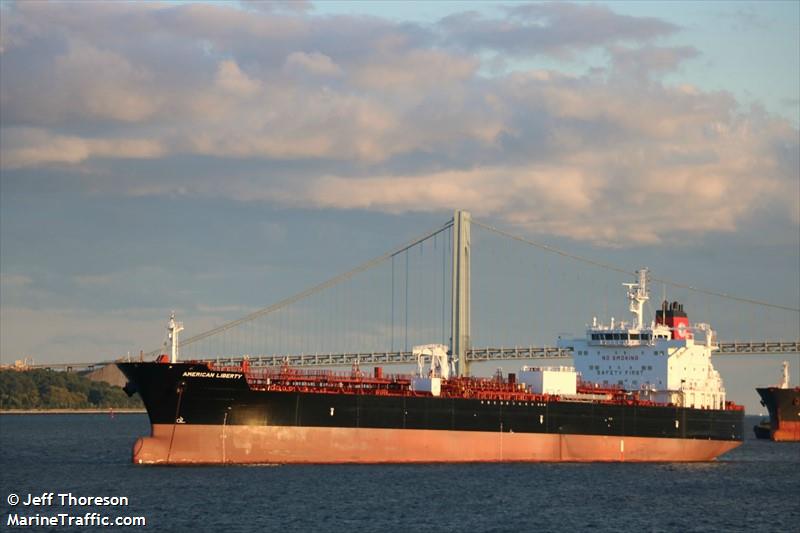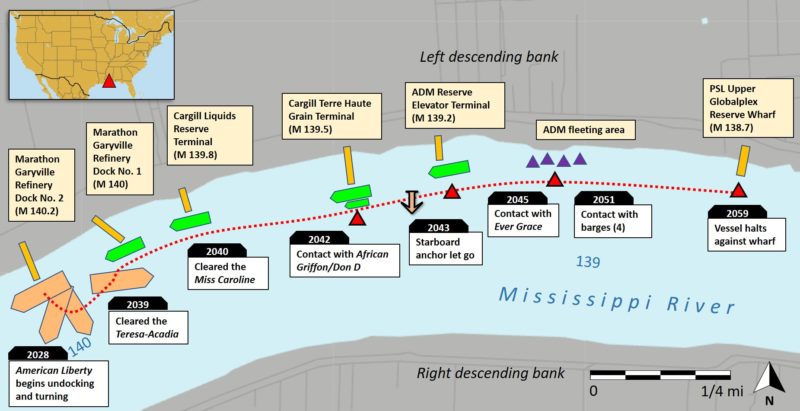.....o πονηρός ο πλοηγός απάντησε ότι δεν κύτταξε εάν το πηδάλιο ήταν στην θέση που είχε πει, και αν η μηχανή έκανε την κίνηση, που είχε δώσει.
Αλλά , φταίνε και οι καπεταναίοι, που τους αφήνουν να κάνουν τον καμπόσο στην γέφυρα που μπαίνει για πρώτη φορά.
Άλλος ένας πατσαβούρης ψεύτης από τους πολλούς ανίκανους που υπάρχουν στον χώρο.
+++

File Photo. MT American Liberty. Photo: MarineTraffic.com/Jeff Thoreson
“While the NTSB did not issue any safety recommendations in our report, that does not mean there are not life-saving lessons to be learned from this accident,” said Morgan Turrell, Acting Director of the NTSB’s Office of Marine Safety. “There could have been a very different outcome in this accident, and failure to learn from it could cause a similar and potentially deadly accident to happen.”
The accident happened while the river was at major flood stage with the Baton Rouge, Louisiana, gage reading 43.6 feet and the Bonnet Carré Spillway at mile 128 reopened six days before the accident. The current was 6.2 knots.
The American Liberty was on its normal route, loading petroleum cargo at the Marathon Petroleum Garyville, Louisiana, Dock No. 2, and sailing to Tampa Bay, Florida. There were 23 crewmembers aboard.

An Associated Federal Pilots and Docking Masters of Louisiana pilot was aboard the American Liberty as it prepared to depart Garyville, the evening of May 16. Two assist tugs were in position – the Josephine Anne and the Vera Bisso. The Josephine Anne, equipped with twin 4,000 horsepower Z drive propellers, had one line on the port bow of the American Liberty. The Vera Bisso, equipped with twin 4,200 conventional propellers, was standing by on the port quarter of the American Liberty with no line on.
The pilot issued rudder and engine commands to the assist tugs from both bridge wings of the tanker. The tanker’s master relayed the pilot’s helm and engine commands to the third mate. The third mate on watch operated the engine order telegraph and monitored rudder orders by watching the rudder angle indicators. An able seaman was the helmsman.
Investigators found the American Liberty’s Voyage Data Recorder captured the master-pilot exchange, which both pilot and master told investigators was satisfactory but not comprehensive. Both told investigators they shared an understanding of how the undocking maneuver was to be executed, but the exchange did not address how far the vessel was to be off the dock when the ship was to start turning, when the tugs were to be let go, or any other precautions that might be necessary in the faster-than-normal river current. Although the master and pilot expressed current as a known concern and challenge, the master-pilot exchange did not address challenges or precautions from the fast current.
The master said everything was normal as they were coming off the wharf, but the current caught the vessel as they tried to go ahead and they could not gain enough headway in the river and slow the rate of the turn. The pilot said he did not get the turns for slow ahead and the current set the vessel toward the wharfs, but he had not looked at the rpm and rudder angle indicators to verify if his commands were carried out.
Investigators also determined that both tugs should have been used alongside the American Liberty until the undocking maneuver was completed and the pilot had established control of the vessel in the current.
The NTSB determined the probable cause of the accident was poor bridge resource management and miscommunication between the pilot and the master, which led to the bridge team’s delay in carrying out an engine order, which delayed the American Liberty in attaining sufficient speed to conduct an undocking maneuver. The decision to release tugs begore the undocking maneuver was complete, contributed to the accident.
The 50,000 dwt MT American Liberty is a Jones Act-compliant product tanker built in 2017 by Philly Shipyard for American Petroleum Tankers, a subsidiary of Kinder Morgan.
Marine Accident Brief 20/39 is available online at https://go.usa.gov/xAgaj
.
Δεν υπάρχουν σχόλια:
Δημοσίευση σχολίου